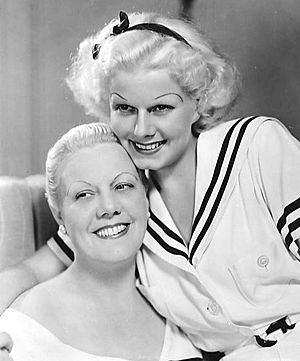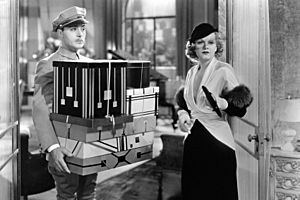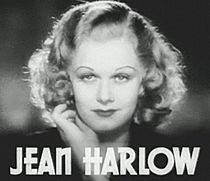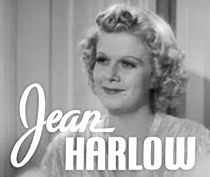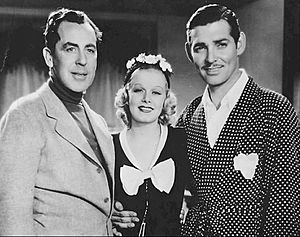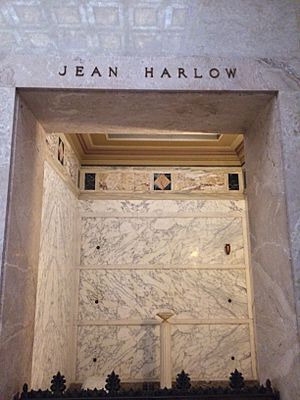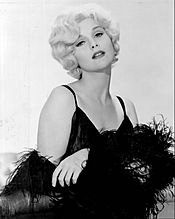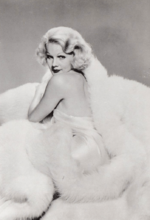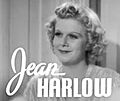Jean Harlow facts for kids
Quick facts for kids
Jean Harlow
|
|
|---|---|
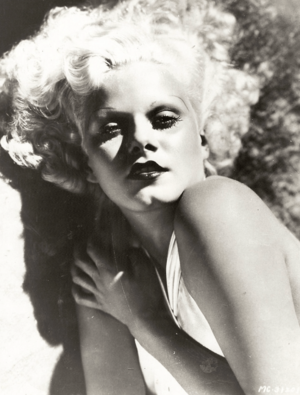
Harlow in 1933
|
|
| Born |
Harlean Harlow Carpenter
March 3, 1911 Kansas City, Missouri, U.S.
|
| Died | June 7, 1937 (aged 26) Los Angeles, California, U.S.
|
| Cause of death | Kidney failure |
| Resting place | Forest Lawn Memorial Park |
| Occupation | Actress |
| Years active | 1928–1937 |
| Spouse(s) |
Charles McGrew
(m. 1927; div. 1929)Paul Bern
(m. 1932; died 1932)Harold Rosson
(m. 1933; div. 1934) |
| Partner(s) | William Powell (1934–1937) |
Jean Harlow (born Harlean Harlow Carpenter; March 3, 1911 – June 7, 1937) was a famous American actress. She was a big star during the early years of sound films in Hollywood. People often called her the "Platinum Blonde" because of her very light hair. She was known for playing strong, confident women who were also funny.
Even though Jean Harlow was only in movies for nine years, she became one of Hollywood's biggest stars. Her image is still remembered today. In 1999, the American Film Institute named her one of the greatest female movie stars of all time.
Jean Harlow first got a big role in the movie Hell's Angels (1930), directed by Howard Hughes. Later, Metro-Goldwyn-Mayer (MGM) signed her. She starred in many successful movies like Red-Headed Woman (1932), Red Dust (1932), and Dinner at Eight (1933). Her popularity grew so much that she became more famous than other top actresses at MGM.
Sadly, Jean Harlow died at just 26 years old from kidney failure while filming Saratoga. MGM finished the movie using other actors to stand in for her. Saratoga was released soon after her death and became MGM's most successful film of 1937. It was also her highest-earning movie.
Contents
Early Life and Family
Jean Harlow was born Harlean Harlow Carpenter in Kansas City, Missouri. Her father, Mont Clair Carpenter, was a dentist. Her mother, Jean Poe Carpenter, came from a wealthy family. Her grandfather, Skip Harlow, was a successful real estate broker. In 1908, her grandfather arranged for her mother to marry Mont Clair Carpenter. However, her mother was not happy in the marriage.
Harlean was called "The Baby" by her family, a nickname that stayed with her throughout her life. She was very close to her mother, who was very protective. Later, when Harlean became a star, her mother was known as "Mama Jean."
When Harlean was at school, her mother divorced her father in 1922. Her mother got full custody of Harlean. After the divorce, Harlean did not see her father very often, even though she loved him.
In 1923, Harlean's mother moved them to Hollywood. She hoped to become an actress, but she was told she was too old. Harlean went to the Hollywood School for Girls, where she met other future stars. She left school at age 14 in 1925.
When their money ran low, Harlean and her mother moved back to Kansas City. Harlean then went to summer camp in Michigan, where she got sick with scarlet fever. Her mother traveled to care for her but was not allowed to see her.
Harlean later attended the Ferry Hall School in Lake Forest, Illinois. Her mother chose this school because it was near the home of her boyfriend, Marino Bello.
First Marriage
During her first year at Ferry Hall School, Harlean met Charles "Chuck" Fremont McGrew III. He was 19 years old and came from a wealthy family. They started dating seriously in 1926 and got married in 1927. Harlean's mother also married Marino Bello that same year, but Harlean did not go to her mother's wedding.
In 1928, Harlean and Chuck moved to Beverly Hills, California. Chuck had received some of his family's money. Harlean enjoyed being a wealthy socialite, attending parties and events. Neither of them worked at this time. Chuck hoped the move would create some distance between Harlean and her mother.
Becoming an Actress
Early Roles as an Extra
While living in Los Angeles, Harlean became friends with Rosalie Roy, who wanted to be an actress. One day, Harlean drove Rosalie to Fox Studios. While waiting, studio executives noticed Harlean. Even though she said she wasn't interested, she was given information for Central Casting, which helps find actors for movies.
A few days later, Rosalie dared Harlean to go to an audition. Harlean didn't want to lose the bet, and her enthusiastic mother encouraged her. So, Harlean went to Central Casting and signed up using her mother's maiden name, Jean Harlow.
After turning down several job offers, her mother finally convinced her to accept a small role. Harlean appeared in her first film, Honor Bound (1928), as an "extra" (a background actor) for $7 a day. This led to more small parts in films like Moran of the Marines (1928). In December 1928, Jean Harlow signed a contract with Hal Roach Studios. She had small roles in Laurel and Hardy short films in 1929, like Double Whoopee and Bacon Grabbers.

In March 1929, she left Hal Roach Studios because she felt acting was hurting her marriage. In June 1929, Harlow separated from her husband and moved in with her mother and stepfather. She continued working as an extra until she got her first speaking role in the film The Saturday Night Kid. She and Chuck McGrew divorced in 1929.
The Platinum Blonde Star
In late 1929, actor Ben Lyon noticed Harlow while he was filming Hell's Angels for Howard Hughes. Hughes was re-filming parts of his silent movie with sound and needed a new actress. Harlow screen-tested for Hughes, who gave her the part and signed her to a contract. During filming, Harlow met MGM executive Paul Bern.

Hell's Angels premiered in May 1930 and became the highest-earning film of that year. This movie made Jean Harlow an international star. Even though audiences loved her, some critics were not impressed with her acting.
Hughes loaned Harlow out to other studios. She appeared in films like The Secret Six (with Wallace Beery and Clark Gable) and The Public Enemy (with James Cagney). Even though these films were successful, critics still made fun of Harlow's acting skills.
Columbia Pictures cast Harlow in a film that was renamed Platinum Blonde to highlight her famous hair color. Harlow said her hair was not bleached, but the very light "platinum" color was reportedly achieved with strong chemicals. Many female fans started dyeing their hair to match hers. Hughes' team even offered a $10,000 prize to any beautician who could match Harlow's shade, but no one could. The "Platinum Blonde" nickname stuck with her.
Paul Bern then helped her get a role in MGM's The Beast of the City (1932). After filming, Harlow went on a tour to meet fans on the East Coast. To everyone's surprise, she was incredibly popular and drew huge crowds. Despite what critics said about her acting, Harlow's fan base was growing rapidly.
Success at MGM
Paul Bern, who was now dating Harlow, convinced Irving Thalberg, the head of production at MGM, to sign her. Thalberg was hesitant at first because MGM's leading ladies were usually very elegant, and Harlow's screen image was different. But he agreed, and on March 3, 1932, her 21st birthday, MGM bought her contract from Hughes for $30,000. Harlow officially joined MGM in April 1932.
At MGM, Harlow was given better roles that showed off her beauty and growing talent for comedy. She starred in the comedy Red-Headed Woman (1932), where she earned $1,250 a week. This film was important because it was one of the first where she was seen as a serious actress. She wore a red wig for this role, which was unusual for her.
Her next film was Red Dust, her second movie with Clark Gable. Harlow and Gable worked very well together and starred in six films in total. She also worked many times with Spencer Tracy and William Powell. MGM tried to change Harlow's public image to be more "all-American" by saying her family name was "Carpentiér" and that she was related to writer Edgar Allan Poe.
During the filming of Red Dust, her husband, Paul Bern, was found dead at their home. This caused a big scandal. MGM worried about bad publicity and considered replacing Harlow in the film. However, Harlow remained strong and became even more popular after this difficult time.
After Bern's death, the studio arranged for Harlow to marry cinematographer Harold Rosson. They divorced quietly eight months later.
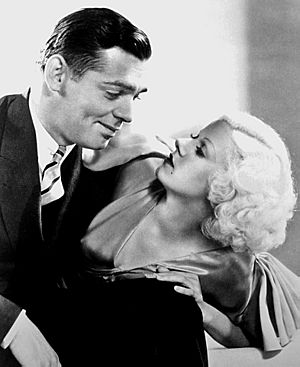
By 1933, MGM realized how popular the Harlow-Gable team was. They paired them again in Hold Your Man (1933), which was also a big hit. That same year, she appeared in the star-filled comedy-drama Dinner at Eight.
She continued to star in successful films with Gable, including China Seas (1935) and Wife vs. Secretary (1936), which also starred Myrna Loy and James Stewart.
From 1933 onwards, Jean Harlow was consistently one of the most popular movie stars in the United States. Her popularity continued to grow, even as other female stars at MGM became less popular. Harlow's movies made a lot of money at the box office, even during the Great Depression.
After her third marriage ended in 1934, Harlow fell in love with William Powell, another MGM star. They were reportedly engaged for two years, but they never officially married. They starred together in her first musical film, Reckless (1935).
She then starred in Suzy (1936) and Libeled Lady (1936), which received good reviews for her comedic performance. Her final completed film was the comedy Personal Property (1937), co-starring Robert Taylor.
Illness and Death

In January 1937, Jean Harlow traveled to Washington, D.C., with Robert Taylor to help raise money for President Franklin D. Roosevelt's birthday. The trip was tiring, and she caught the flu. She recovered in time to attend the Academy Awards ceremony with William Powell.
Filming for her last movie, Saratoga, with Clark Gable, was supposed to start in March 1937. However, production was delayed because Harlow became very sick after having a wisdom tooth removed. She was hospitalized but recovered almost two months later, and filming began on April 22, 1937. She also appeared on the cover of Life magazine in May.
On May 20, 1937, while filming Saratoga, Harlow started feeling unwell. Her symptoms included tiredness, nausea, and stomach pain. The studio doctor thought she had a gallbladder issue and the flu. Co-star Una Merkel noticed Harlow looked pale and tired and had gained weight.
On May 29, during a scene where her character had a fever, Harlow was clearly sicker than her character. She leaned against Clark Gable and said, "I feel terrible! Get me back to my dressing room." She asked for William Powell, who immediately took her home.
The next day, Powell found Harlow's condition had not improved. He called her mother and insisted she return home. He also called a doctor. On June 2, it was announced she was suffering from the flu again. Dr. Ernest Fishbaugh, who treated her, thought she had an inflamed gallbladder. Her mother told MGM that Harlow was feeling better, and co-workers expected her back on set by June 7.
However, another doctor, Dr. Leland Chapman, was called in. He realized that Harlow was not suffering from a gallbladder issue but was in the final stages of kidney failure. On June 6, 1937, Harlow said she couldn't see Powell clearly.
That evening, she was taken to Good Samaritan Hospital in Los Angeles, where she fell into a coma. The next day, June 7, 1937, Jean Harlow died at 11:37 a.m. at the age of 26. The doctors said the cause of death was swelling in the brain, a complication of kidney failure.

Jean Harlow was buried in the Great Mausoleum at Forest Lawn Memorial Park in Glendale. William Powell bought a private room for her burial. She was buried in the dress she wore in Libeled Lady, holding a white gardenia and a note from Powell that said, "Goodnight, my dearest darling." Her gravestone reads, "Our Baby."
Spaces in the same room were saved for Harlow's mother and William Powell. Her mother was buried there in 1958. However, Powell married actress Diana Lewis in 1940 and was buried elsewhere after his death in 1984.
MGM decided to finish Saratoga using three body doubles for Harlow and by rewriting some scenes. The film was released on July 23, 1937, less than two months after her death. It was a huge success, becoming MGM's most successful film of the year and the highest-earning film of Harlow's career.
Legacy
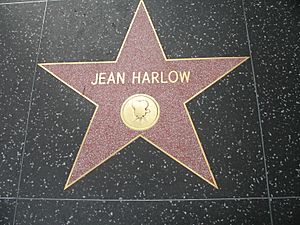
A cocktail was named after her, called the "Jean Harlow," made with light rum and sweet vermouth.
The famous blues musician Lead Belly wrote a song called "Jean Harlow" after hearing about her death while he was in prison.
On February 8, 1960, Jean Harlow received a star on the Hollywood Walk of Fame in Los Angeles, California.
Her signature, handprints, and footprints were placed in cement on September 29, 1933, at Grauman's Chinese Theatre in Hollywood.
Novel
Harlow wrote a novel called Today Is Tonight. She intended to write the book around 1933–1934, but it was not published during her lifetime. Louis B. Mayer, the head of MGM, prevented the book from being sold using a clause in Harlow's contract. After her death, her mother sold the film rights to MGM, but no film was ever made. The book was finally published in 1965.
Film Portrayals
In 1965, two films about Jean Harlow were released, both titled Harlow. The first film starred Carol Lynley, and the second starred Carroll Baker. Both movies were not well-received and did not do well at the box office.
In 2004, Gwen Stefani briefly played Jean Harlow in Martin Scorsese's movie The Aviator, which was about Howard Hughes.
Images for kids
-
Harlow stands beside Eleanor Roosevelt, with other invited celebrities, after the President's Birthday Ball luncheon, at the White House, 30 January 1937
See also
 In Spanish: Jean Harlow para niños
In Spanish: Jean Harlow para niños


